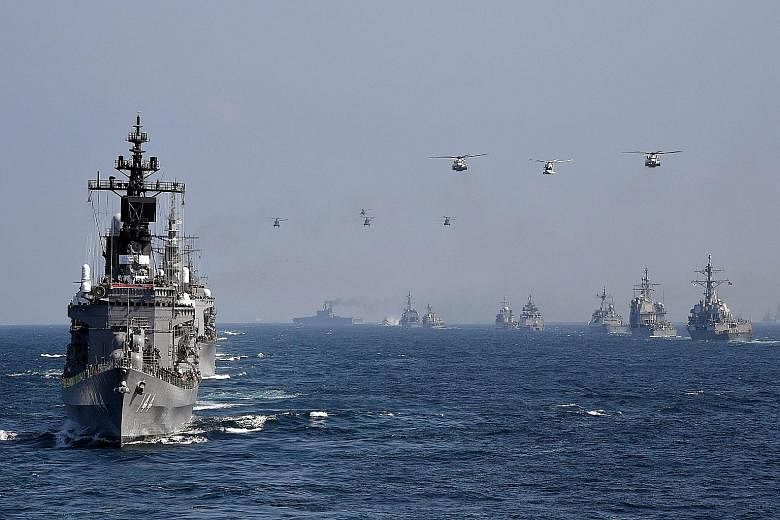TOKYO • An armada of carriers, destroyers, submarines and a cruiser have gathered off Japan's coast in a display of naval power that showcased Tokyo's latest warships and signalled wider engagement by the US Navy in the western Pacific.
The fleet review in seas near Tokyo yesterday was the first major display of Japanese military hardware since Prime Minister Shinzo Abe won lawmaker approval for legislation that, for the first time since World War II, will allow Japanese soldiers to defend their foreign allies.
Mr Abe is pursuing a doctrine of collective self-defence with allies which is meant to give Japan a bigger role in regional security in order to counterbalance the military power of an increasingly assertive China.
Neighbouring China - which is involved in maritime disputes in the East China Sea with Japan, and in the South China Sea with several South-east Asian countries - has said that it is wary of Japan's changing defence posture. Mr Abe, in an address after the maritime show, told sailors to gird themselves for future missions and "to continue to guard the nation's peace".
Joining the Japanese navy were vessels from India, South Korea, Australia, France and the United States, including the Japan-based aircraft carrier, the 333m-long USS Ronald Reagan. Altogether, 50 vessels and 61 aircraft participated in the display, which is held every three years.
The centrepiece of Japan's naval line-up was the Izumo helicopter carrier, Japan's biggest warship since World War II. The 248m-long flat-top, which was commissioned in May, is a highly visible example of how Japan is expanding its military capability to operate overseas.
The Maritime Self-Defence Force designates the vessel as a destroyer, keeping it within the bounds of a pacifist Constitution that forbids Japan from possessing the means to wage war, such as force-projecting carriers.
In a signal that the Japanese navy's growing role in Asia will be accompanied by the US fleet's wider engagement in the region, the US Navy sent Vice-Admiral Nora Tyson, commander of the powerful Eastern Pacific Third Fleet, to join Mr Abe on his ship.
Her presence comes after the US scrapped an administrative boundary running along the international dateline in the Pacific that demarcated the operating areas for the Seventh and Third Fleets.
The change gives Vice-Admiral Tyson a command role in the western Pacific, and will allow the US to deploy vessels quickly to trouble spots in the region, Chief of Naval Operations John Richardson said at a press briefing in Tokyo last Thursday.
"Admiral Tyson's presence here is just a recognition that we are trying to be as flexible as possible to keep as many options on the table as possible so that we can be as responsive as possible," said the US Navy's most senior uniformed officer.
The forward-deployed Seventh Fleet, with some 80 vessels, including the USS Ronald Reagan, is the most powerful naval force in the western Pacific. The Third Fleet, with its home port in San Diego, includes four carrier strike groups.
REUTERS

